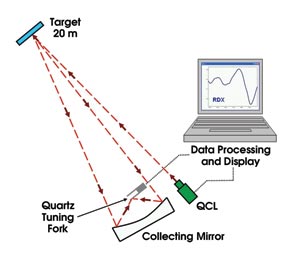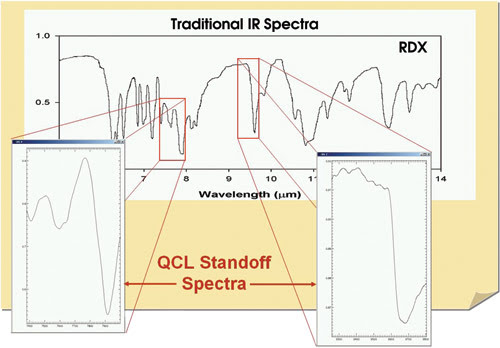Combining a quantum cascade laser and a crystal tuning fork gets to the heart of chemical identification from meters away.
Hank Hogan
By taking advantage of an accidental discovery, researchers at Oak Ridge National Laboratory in Tennessee have demonstrated a detector that can spot explosives at distances of more than 20 yards. Possibly useful for uncovering bombs and anything with a telltale chemical signature, eventually it could be developed into a compact handheld system, said researcher Larry R. Senesac.

Shown is a setup for detecting explosives at a distance: Pulsed infrared light from a quantum (QCL) cascade laser reflects off the target. A mirror focuses the light onto a quartz tuning fork sensor, producing a photoacoustic signal. A computer captures the vibration signal from the tuning fork, recording it as a function of illumination wavelength. A dip or peak in the signal at specific wavelengths acts as a chemical signature, enabling remote detection of the residue of explosives. Images courtesy of Oak Ridge National Laboratory.
The device works by illuminating a sample with a pulsed infrared laser and detecting the scattered light with a quartz crystal tuning fork. The more light absorbed at the target, the less is reflected to be absorbed by the detector. By measuring the sound produced by the reflected light, the investigators can detect chemicals at a distance on a target.
Senesac noted that the technique derived from a chance discovery that occurred when the group tried to detect the photoacoustic signal from the target at a distance and in atmosphere. “While trying to gather more sound with a parabolic reflector, we accidentally captured the reflected light from the surface and focused it on the surface of the microphone,” he said.

Standoff photoacoustic spectra of the explosives residue cyclotrimethylenetrinitromine (RDX) at 20 m: As the target chemical absorbs the IR laser radiation as a function of wavelength, the energy reflected to the tuning fork detector drops, resulting in a decrease of the signal from the detector. Here, the spectrum of the traditional IR absorption reference spectrum of RDX is plotted, along with the inverted data from IR wavelength scan ranges in the corresponding inset plots. The match allows the device to identify the presence of explosives residue.
After confirming that the signal was indeed coming from the light, the researchers tried several methods to improve the signal-to-noise ratio. Eventually they turned to a quartz crystal tuning fork, with the result that the ratio immediately improved from about three to more than 200. That figure was pushed even higher through a redesign of the support electronics.
Another enabling technology was a quantum cascade laser from Daylight Solutions Inc. of Poway, Calif. The scientists needed a tunable mid-infrared source with a pulse rate suitable for the tuning fork, which requires a modulated signal near its 32-kHz resonance frequency. The light source had to have a sufficient tuning range to detect the chemicals of interest, and it had to be a powerful, coherent beam so that a point on the target’s surface could be interrogated.
In their demonstration, the researchers fired the laser using the tuning fork’s resonance frequency at a stainless steel target, onto which they had deposited explosives residue such as trinitrotoluene (TNT). They collected the reflected light using a mirror and focused it onto a Citizen quartz crystal tuning fork. They then adjusted the laser from about 9.26 to 9.80 μm in 0.01-nm steps. The reflected light intensity changed as the laser’s output was absorbed, leading to a measurable change in the amplitude of the tuning fork. The device had a detection limit of 100 ng of material per square centimeter of target at a standoff distance of up to 20 m.
The device has the advantage of using low-power IR lasers and thus is eye-safe, unlike other standoff techniques that use visible lasers. Because of the quartz crystal tuning fork, it can be compact, low in cost and operable in field conditions – something not possible with other photoacoustic methods.
“However, our main thrust is toward increasing our library of detected materials of interest and on mixtures of materials.
Applied Physics Letters, Vol. 92, 234102.